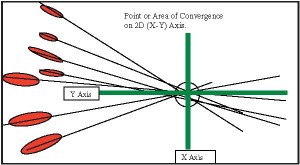Blood spatter is an important topic in the courtroom..
The open question is where is the validation for this discipline of forensic science?
If you have ever been involved in any sort of homicide case, you will almost always run across the “blood whisperers” which are folks who honestly believe that blood left at a scene can “tell us the story of the crime”.
Some thoughts:
Blood spatter analysis can be helpful in a number of different ways. It can mostly be used as a way of eliminating possibilities. By itself, it cannot confirm or prove what actually occurred. It is at most an exclusionary tool. However, as currently practiced in the United States today, it is being be used to suggest the kind of injury sustained, the final movements of the victim, and the angle of the shooting or attack.
One of the assumptions made by those who practice this form of forensic science discipline is that in examining the stains, the number of stains found will be dependent on the nature and site of the injury, the presence of any intermediate targets such as clothing, and the nature of the projectile used to cause the wound. Furthermore, they posit that the closer the projectile is to the target, the more spatter will be found and such spatter will look like as if it was created from a spray can. Conversely, they postulate that the farther away the projectile is from the target, the less mist-like spatter stains will be produced.
They attempt to subjectively categorize the universe of possibilities of spatter into two different types of spatter: forward spatter and backward spatter. Both types, they say, will be emitted in a conical fashion in that the impact of the projectile will create a path which expands out from the impact site and grow in width as the spatter moves forward as it is projected. Back spatters, they contend, will almost always be possible whereas forward spatter will only occur when an exit wound occurs.
Additionally they state that the following as basic fundamental principles:
- Gunshot spatter, in particular, will exhibit larger stains beyond that of the aerosol or atomized stains discussed above. These larger stains will usually display a 1-2 mm diameter and will be included among the aerosol/atomized stains (those which appear as if created by a spray can). Due the small size of the blood, the blood will only carry 4-5 feet. When shot at a 4 foot range, the gunshot wound could deposit stains on the weapon, shooter’s body and or any clothing involved., Furthermore, the small size of such blood can also cause such stains to be easily overlooked both the by the shooter and by the investigator.
- The forward spatter involved will be more symmetrical than the back spatter due to the primary force of the impact being transmitted in the direction of the projectile. Additionally, forward spatter will result in a more intense pattern because the majority of the projectile force is concentrated along the vector of the projectile. The back spatter, on the other hand, will be less defined, slightly larger, and have fewer particles. While back spatter is more possible than forward spatter, the presence of back spatter will be partly dependent on the manner and distance at which the weapon is held.
- While a number of scientists have debated what causes the spatter, there appears to be some agreement that the spatter is created by the collapse of the temporary wound cavity which is created by projectile disrupting the victim’s tissue. In a situation where two shots are fired, the blood spatter from the second shot will be much heavier because the tissue surrounding the first wound would compress and cause the blood filling that first wound to “squirt” out its contents and the closer the location of the wounds to each other, the more dramatic the effect, resulting in heavier spatter from the second shot.
- Finally, cast off stains will result from blood being flung from a secondary object which could be from the weapon, victim, or subject.
One of the many problems with all of this is the true lack of meaningful validation of these tenets. There is more. There is also a lack of education in the practitioners as to the real science that involves the above. They attempt to apply and to interpret the real science based upon that which they objectively see to extrapolate it out to that which they subjectively conclude without the basic understanding of “why”.
Frequently, these folks have no real understanding in fluid dynamics [which is a sub-discipline of fluid mechanics that deals with fluid flow—the natural science of fluids (liquids and gases) in motion], Rheology [which is the study of the flow of matter: primarily in the liquid state, but also as ‘soft solids’ or solids under conditions in which they respond with plastic flow rather than deforming elastically in response to an applied force], cannot explain or understand the difference between Viscoplasticity [which is a theory in continuum mechanics that describes the rate-dependent inelastic behavior of solids] and Viscoelasticity [which is the property of materials that exhibit both viscous and elastic characteristics when undergoing deformation] and they cannot reduce their theory to any sort of mathematical equation involving these concepts.
There certainly needs to be more validation in this discipline of forensic science.




